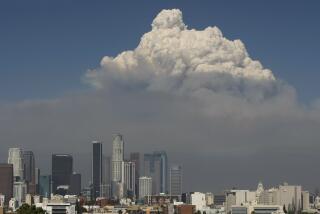Human-caused ignitions spark California’s worst wildfires but get little state focus
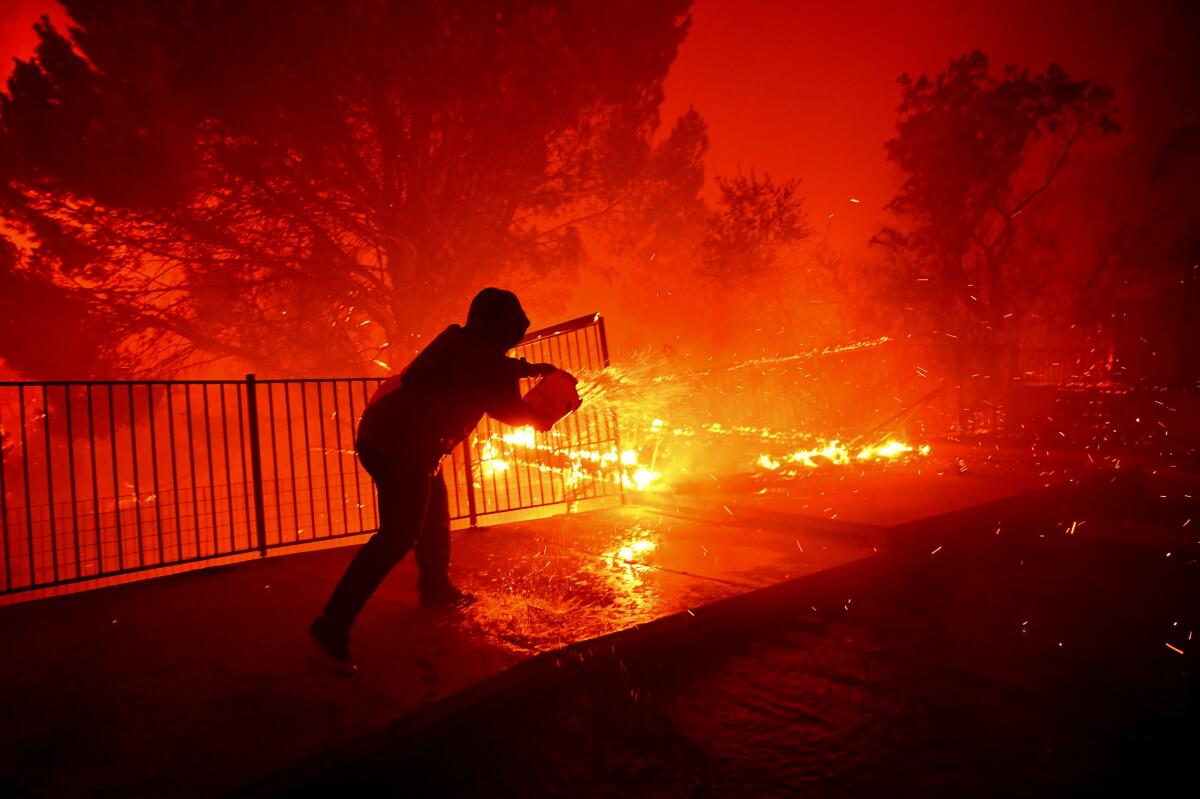
It could have been another bad wildfire year in California. A bountiful summer crop of quick-to-burn dead grass carpeted the hillsides. Autumn was warm and dry. A record-breaking stretch of fire weather hit the Bay Area in October.
But it wasn’t. California wildfires charred about 270,000 acres in 2019, the smallest number since 2011. The three fatalities and roughly 735 burned structures were a fraction of the catastrophic losses of the previous two fire seasons.
The lower than expected toll followed an unusually wet spring and big snowpack, which slowed the start of the fire season. The installation of backcountry fire cameras gave firefighting crews early notice of ignitions. When flames approached, evacuation orders were swift and sweeping.
But most critically, widespread preventive power shutdowns by the state’s largest electric utility diminished the chances of human-related ignitions at critical times — during high, hot winds that can fan a single spark into the kind of unstoppable inferno that destroyed the town of Paradise, Calif., and left 86 people dead in the 2018 Camp fire.
The power blackouts were “likely highly effective in terms of reducing the losses associated with the fire season,” said Stanford University researcher Michael Wara, who served on the state’s Commission on Catastrophic Wildfire Cost and Recovery and recently testified before a congressional committee on wildfire and the electric grid.
Pacific Gas & Electric’s inspections of wind damage to its lines and equipment made it clear that, without preventive shutdowns, “we would have had a significant number of utility-caused fires,” Wara added.
The company found more than 300 spots of damage, according to PG&E court filings. Of those, the utility concluded electrical arcing would probably have occurred at 218 locations if power had been flowing through the lines.
The controversial blackouts disrupted the lives of millions of Californians, including Wara, who spent 6½ days without electricity. But the 2019 record suggests that if the state and utilities take more steps to prevent ill-timed ignitions, lives and property will be saved.
The California Department of Forestry and Fire Protection did not respond to repeated interview requests for this story. But the widespread shut-offs underscore the huge — and often overlooked — role that human-related ignitions play in California wildfire.
It doesn’t matter how dry the vegetation, how fierce the winds or how high the temperature; if there is no ignition, there is no wildfire.
Outside of the Sierra Nevada and the state’s northernmost tier, there is little lightning, nature’s ignition source.
That means that, in much of California, more than 90% of the wildfires are started by people or their equipment. In coastal counties from Sonoma to San Diego, almost all the starts are human related.
In 2018, the worst wildfire year in the state’s record, 1.8 million acres burned in California. Lightning torched only 117,107 acres, according to federal statistics.
Of the known causes of the state’s 20 most destructive wildfires, all are human-related. Half were started by power line or electrical problems, including the two most devastating, the Camp fire, which incinerated 18,804 buildings, and the 2017 Tubbs fire, which killed 22 people and destroyed 5,636 structures.
Other causes of the top destructive blazes include sparks from driving a trailer on the rim of a flat tire (the 2018 Carr fire in Shasta County); a hunter’s small signal fires (the 2003 Cedar fire in San Diego County); and arson (the 2003 Old fire in San Bernardino County).
Human starts aren’t just a California problem. Researchers who analyzed two decades of U.S. records found that, from 1992 to 2012, human activity was responsible for 84% of the wildfires and 44% of the area burned nationally.
The scientists also concluded that people have dramatically expanded the fire season — extending it by far more than a warming climate — because they start fires virtually year-round.
“We’ve forgotten the importance of human ignitions in the mix of this,” said Jennifer Balch, lead author of the 2017 paper, which was published in the Proceedings of the National Academy of Sciences.
“I’m not saying that climate change is not important,” added Balch, who directs the Earth Lab at the University of Colorado-Boulder.
“I’m saying we have a confluence of climate change setting the stage for warmer and drier conditions — and people are providing the ignitions for those large blazes,” she explained. “The convergence and timing is really unfortunate.”
The one hopeful aspect, she said, is that “we can actually do something about it.”
“It’s very different than other natural disasters that are being influenced by climate change,” she said. “We can’t shift the direction of those tropical storms, but we have something to say about where those ignitions are, or aren’t.”
The overall number of ignitions in California has declined since 1980, but the area burned in different parts of the state has either not changed or increased, according to research by Jon Keeley and Alexandra Syphard.
Keeley, a U.S. Geological Survey scientist and leading expert on California wildfire, said there was one notable exception to the downward ignitions trend.
The number of power line-sparked fires has not dropped, and those fires have burned far more acreage since 2000 than during the prior two decades.
“Clearly something is going on,” said Keeley, who offered two possible explanations: The state’s power distribution infrastructure is aging, and the electrical grid has expanded as development pushes farther into wildlands.
Widespread power shutdowns have not been in play long enough to ascertain if they are effective, he said.
Still, Keeley said the 2019 fire season challenges the notion that the horrific wildfire toll of recent years is the “new normal” wrought by climate change.
“People have to recognize there is a lot of serendipity. It has to be the match-up of a number of things” to create catastrophic fires, he added.
One critical match-up is timing.
It is not the number of ignitions that drives wildfire destruction. There were 8,315 fires in California in 2019 — a couple of hundred more than in the devastating 2018 season, according to the National Interagency Fire Center.
It is the conditions under which ignitions occur that matter the most. If it’s a red flag day with single-digit humidity and howling Santa Ana or Diablo winds, chances are greater that a few sparks can quickly explode into a freeway-hopping conflagration that sets entire communities ablaze.
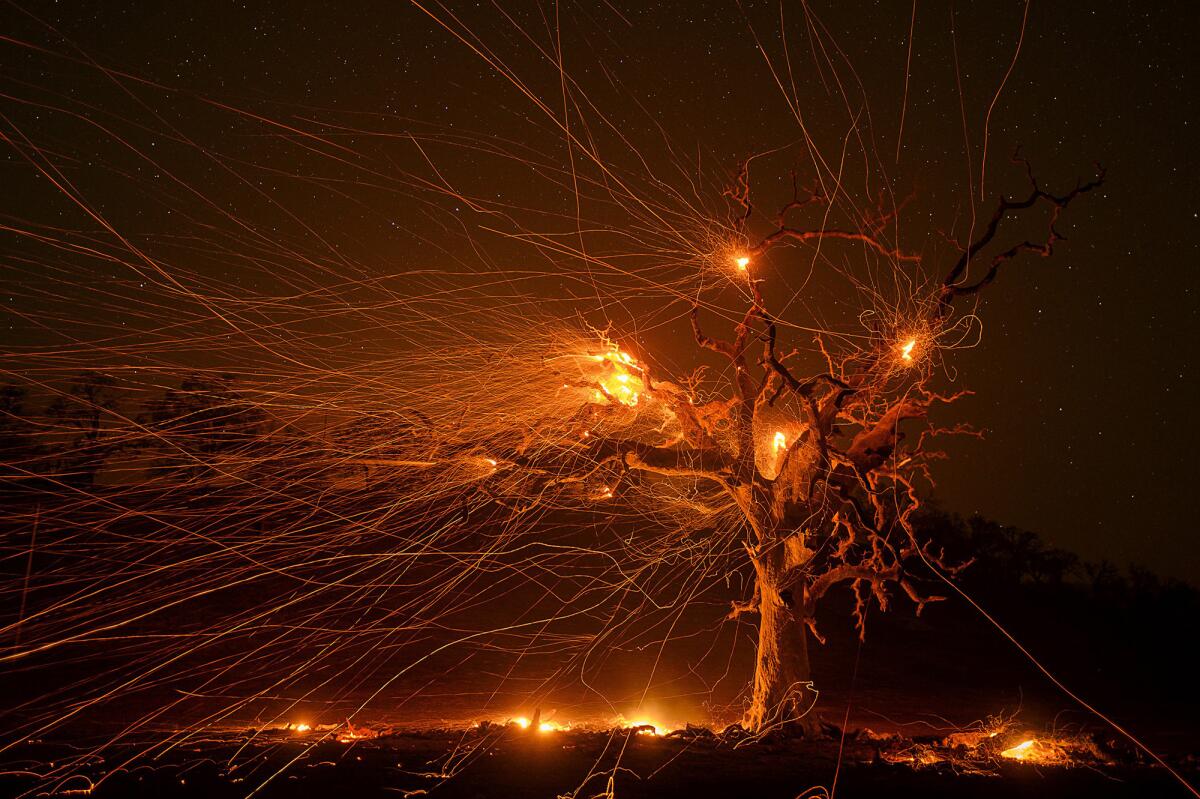
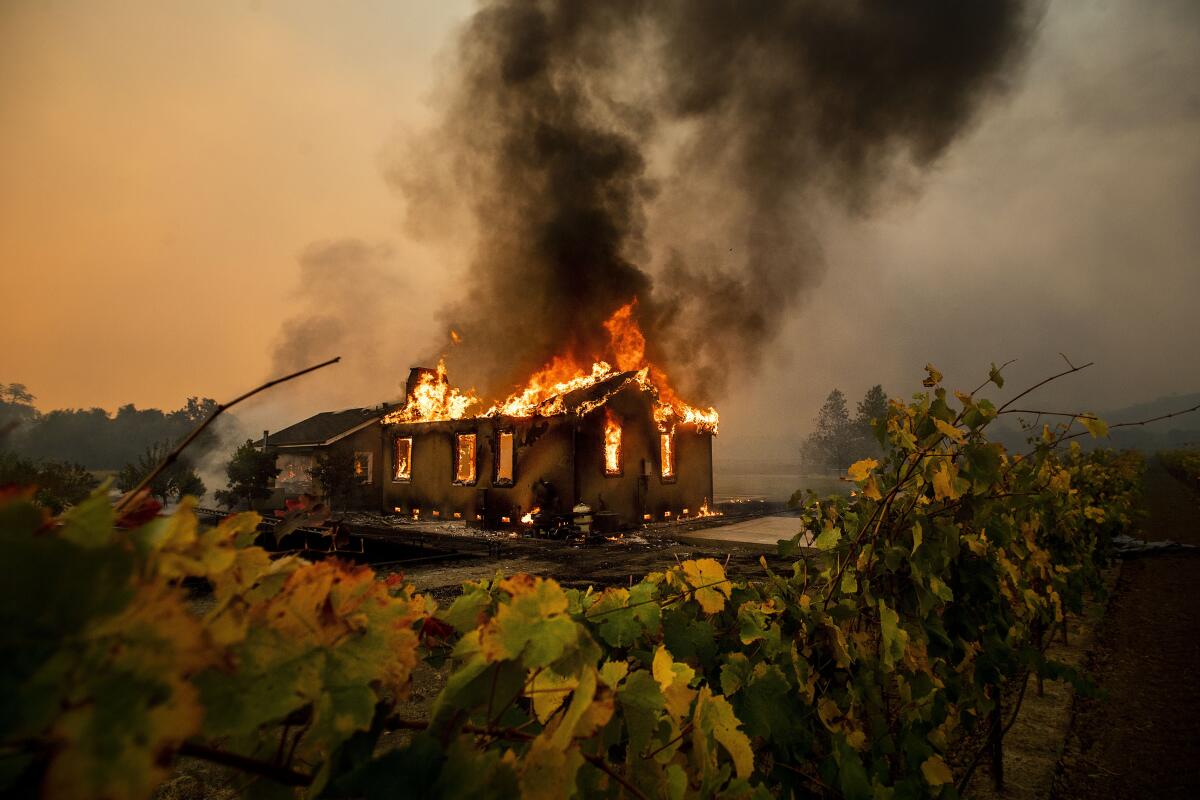
The cause of California’s biggest 2019 wildfire, the Kincade fire, is still officially under investigation. But PG&E has said a high-voltage transmission line that was not powered down during a late October blackout experienced problems near the origin of the blaze, which destroyed 374 structures.
The Kincade fire erupted in the hills of Sonoma County at the beginning of an unusually long stretch of red flag days in the region, which at one point was buffeted by winds gusting to 90 to 100 mph. Statewide, October was the 10th driest on record.
Were it not for the electricity outages, Wara argued, damaged power equipment could have sparked numerous other wind-blown blazes across Northern California at the same time as the Kincade fire. That would have overwhelmed firefighters in a replay of the 2017 wine country conflagrations.
“The Kincade fire was successfully fought by Cal Fire in part because it was the only fire,” he said.
Though downed power lines have caused many of the state’s wildfire disasters, human ignitions run the gamut.
Keeley and Syphard’s analysis of a century of California ignitions, from the early 20th century to 2016, found that equipment use, arson, burning debris, children playing with fire, smoking and vehicles were other leading causes.
The state’s biggest recorded wildfire, the 2018 Mendocino Complex fire in Northern California, started when a rancher drove a stake into the ground to plug a wasp’s nest, throwing sparks into a waist-high bed of dried grass on a hot summer day.
Ranch hands fixing a broken water pipe ignited the 2007 Zaca fire in Santa Barbara County, the state’s sixth-largest fire.
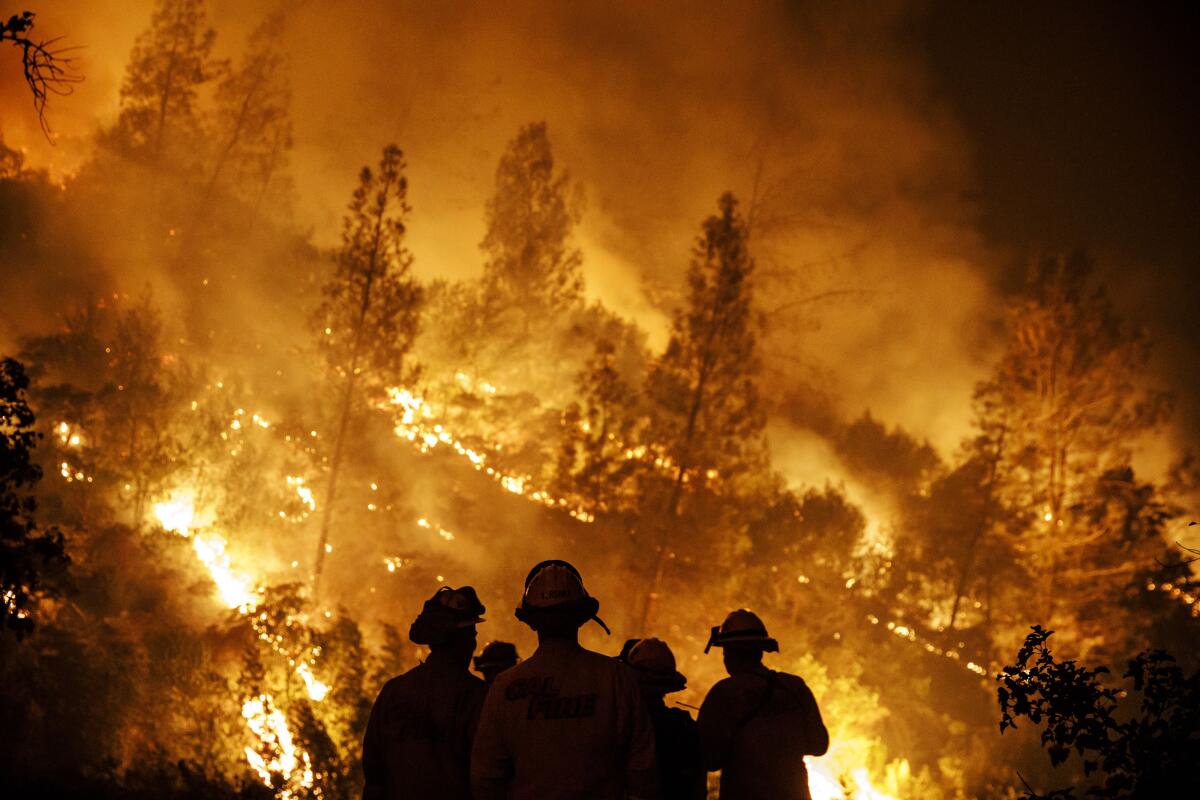

Despite the dominance of human ignitions in California, neighboring regions in the West have taken more aggressive steps to prevent them.
On high fire-risk days in Oregon, for example, the state can limit or completely ban the use of chainsaws, grinding equipment, mowing and other activities on the 13 million acres protected by the Oregon Forestry Department.
In New Mexico and Arizona, the U.S. Forest Service has regularly closed large portions of national forests during peak fire season to prevent a repeat of the disastrous 2011 Wallow fire.
The biggest wildfire in Arizona history, the wind-driven Wallow grew from an unattended campfire the day after the Apache-Sitgreaves National Forest lifted fire restrictions.
“That caused the entire region to take a hard look at our restrictions and closure process,” said Matt Rau, fire staff officer for the Cibola National Forest and National Grasslands in New Mexico.
“If we don’t err on the side of caution and a fire does start, there’s a tremendous amount of scrutiny about the decision or the indecision,” he said, adding that the Southwest’s long-term drought has heightened wildfire concerns.
Even though portions of the Cibola are near metropolitan Albuquerque and it has the highest visitation of New Mexico’s forests, managers closed most of the 1.6 million-acre forest to public access for about three weeks in 2018.
“I would say broadly, there’s support” for the closings, Rau said, adding that forest managers often get questions about why they aren’t restricting access earlier. “We get very little pushback when we close an area for high-fire danger or elevate restrictions.”
Preventive closures are much rarer in California. Though the Forest Service routinely closes areas during and after fires, the agency is reluctant to shut out the public to prevent human ignitions.
“The last thing the Forest Service wants to do is limit access to the public to their national forest system lands,” said Brian Rhodes, the agency’s deputy fire director in California.
John “Pancho” Smith, Santa Barbara District ranger for Los Padres National Forest, spent much of his career in the Southwest, where he fought fires, investigated them and enforced forest closures.
When Smith transferred to the oft-burned Los Padres seven years ago, he asked, “Why don’t we close the forest?”
The answer: “Politically it’s very hard to close a forest. You get a lot of pushback from the public. ‘This is our forest. We want in.’ That kind of thing,” Smith recalled.
From a practical standpoint, Smith said, it would be tough to enforce the closure of a forest like Los Padres, which has many access points.
Moreover, budget cuts have left the forest with fewer people to patrol and enforce restrictions on camp fires or firearm use during periods of high fire danger.
“I don’t believe we do as good [of a] job of prevention as we could,” Smith said. “We just don’t have enough people to actually make those contacts in the field, which is where I believe it’s most important to talk to folks.”
“People love to talk to the forest ranger,” he said. “We just don’t have ‘em any more.”


